Organizational Learning and Change Essay - BUS510 - MBA
VerifiedAdded on 2022/10/18
|9
|2092
|12
Essay
AI Summary
This essay provides a comprehensive analysis of organizational learning and change management, addressing key theories, barriers, and strategies. It examines single and double-loop learning, resistance to change, and the roles of individuals, teams, and leaders in the change process. The essay also integrates biblical frameworks into a contemporary understanding of organizational learning and change. Furthermore, it explores innovative ways to enhance employee learning, align training with organizational culture, and reward learning and development. The content covers strategic and innovative change management, leadership theory, and practice, emphasizing the importance of planning, control, and effective communication. The essay concludes by highlighting the significance of overcoming barriers to organizational learning and fostering a culture of continuous improvement and adaptation within the organization, supported by relevant references.
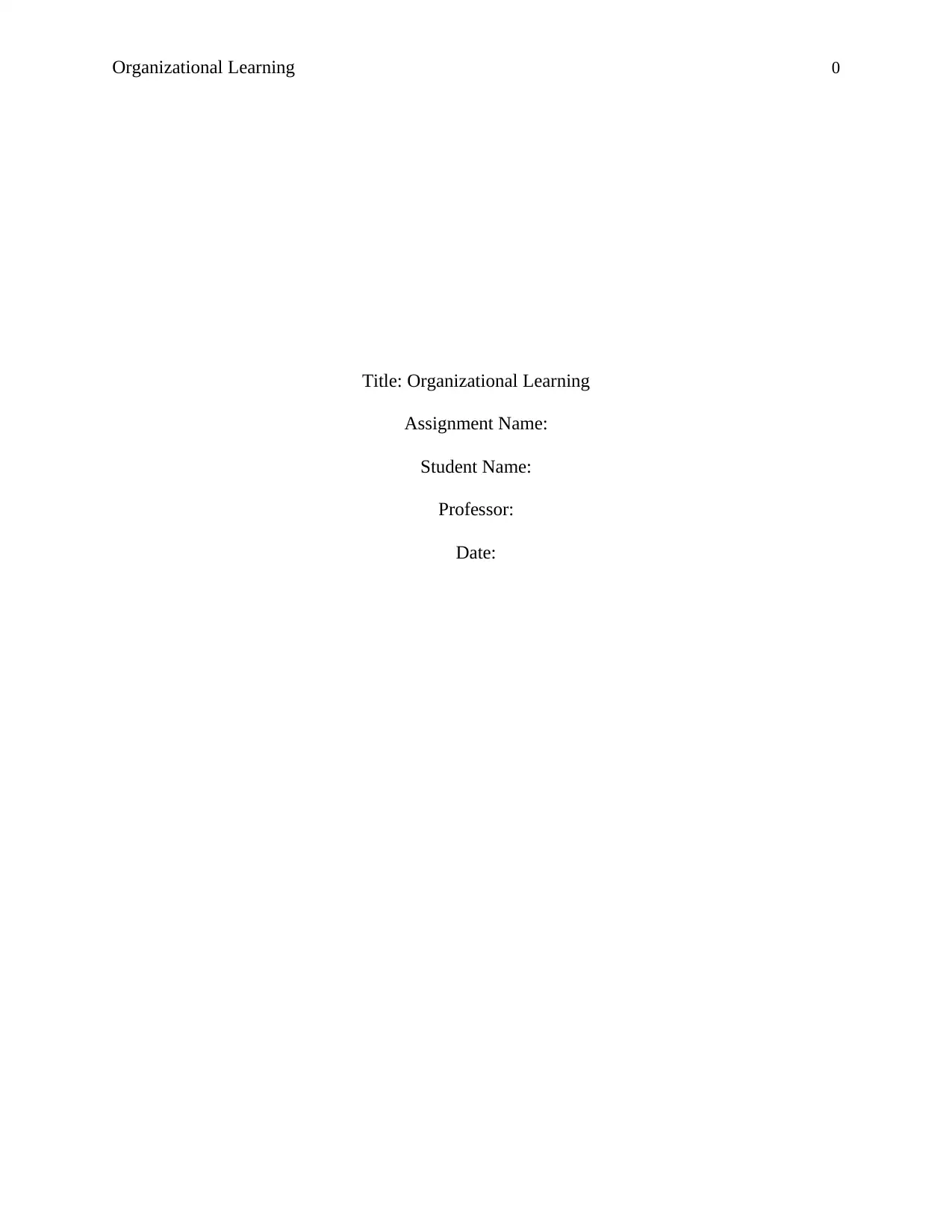
Organizational Learning 0
Title: Organizational Learning
Assignment Name:
Student Name:
Professor:
Date:
Title: Organizational Learning
Assignment Name:
Student Name:
Professor:
Date:
Paraphrase This Document
Need a fresh take? Get an instant paraphrase of this document with our AI Paraphraser
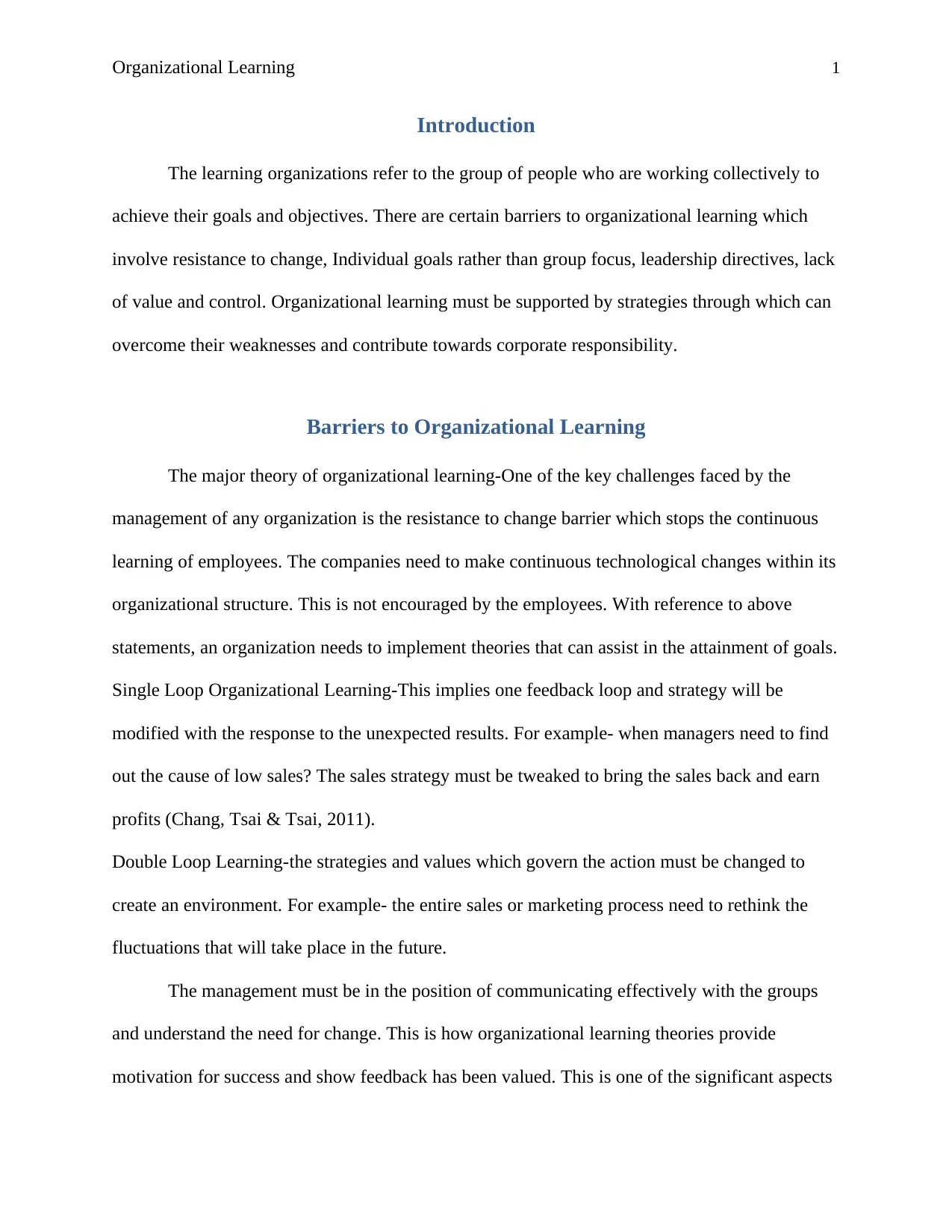
Organizational Learning 1
Introduction
The learning organizations refer to the group of people who are working collectively to
achieve their goals and objectives. There are certain barriers to organizational learning which
involve resistance to change, Individual goals rather than group focus, leadership directives, lack
of value and control. Organizational learning must be supported by strategies through which can
overcome their weaknesses and contribute towards corporate responsibility.
Barriers to Organizational Learning
The major theory of organizational learning-One of the key challenges faced by the
management of any organization is the resistance to change barrier which stops the continuous
learning of employees. The companies need to make continuous technological changes within its
organizational structure. This is not encouraged by the employees. With reference to above
statements, an organization needs to implement theories that can assist in the attainment of goals.
Single Loop Organizational Learning-This implies one feedback loop and strategy will be
modified with the response to the unexpected results. For example- when managers need to find
out the cause of low sales? The sales strategy must be tweaked to bring the sales back and earn
profits (Chang, Tsai & Tsai, 2011).
Double Loop Learning-the strategies and values which govern the action must be changed to
create an environment. For example- the entire sales or marketing process need to rethink the
fluctuations that will take place in the future.
The management must be in the position of communicating effectively with the groups
and understand the need for change. This is how organizational learning theories provide
motivation for success and show feedback has been valued. This is one of the significant aspects
Introduction
The learning organizations refer to the group of people who are working collectively to
achieve their goals and objectives. There are certain barriers to organizational learning which
involve resistance to change, Individual goals rather than group focus, leadership directives, lack
of value and control. Organizational learning must be supported by strategies through which can
overcome their weaknesses and contribute towards corporate responsibility.
Barriers to Organizational Learning
The major theory of organizational learning-One of the key challenges faced by the
management of any organization is the resistance to change barrier which stops the continuous
learning of employees. The companies need to make continuous technological changes within its
organizational structure. This is not encouraged by the employees. With reference to above
statements, an organization needs to implement theories that can assist in the attainment of goals.
Single Loop Organizational Learning-This implies one feedback loop and strategy will be
modified with the response to the unexpected results. For example- when managers need to find
out the cause of low sales? The sales strategy must be tweaked to bring the sales back and earn
profits (Chang, Tsai & Tsai, 2011).
Double Loop Learning-the strategies and values which govern the action must be changed to
create an environment. For example- the entire sales or marketing process need to rethink the
fluctuations that will take place in the future.
The management must be in the position of communicating effectively with the groups
and understand the need for change. This is how organizational learning theories provide
motivation for success and show feedback has been valued. This is one of the significant aspects
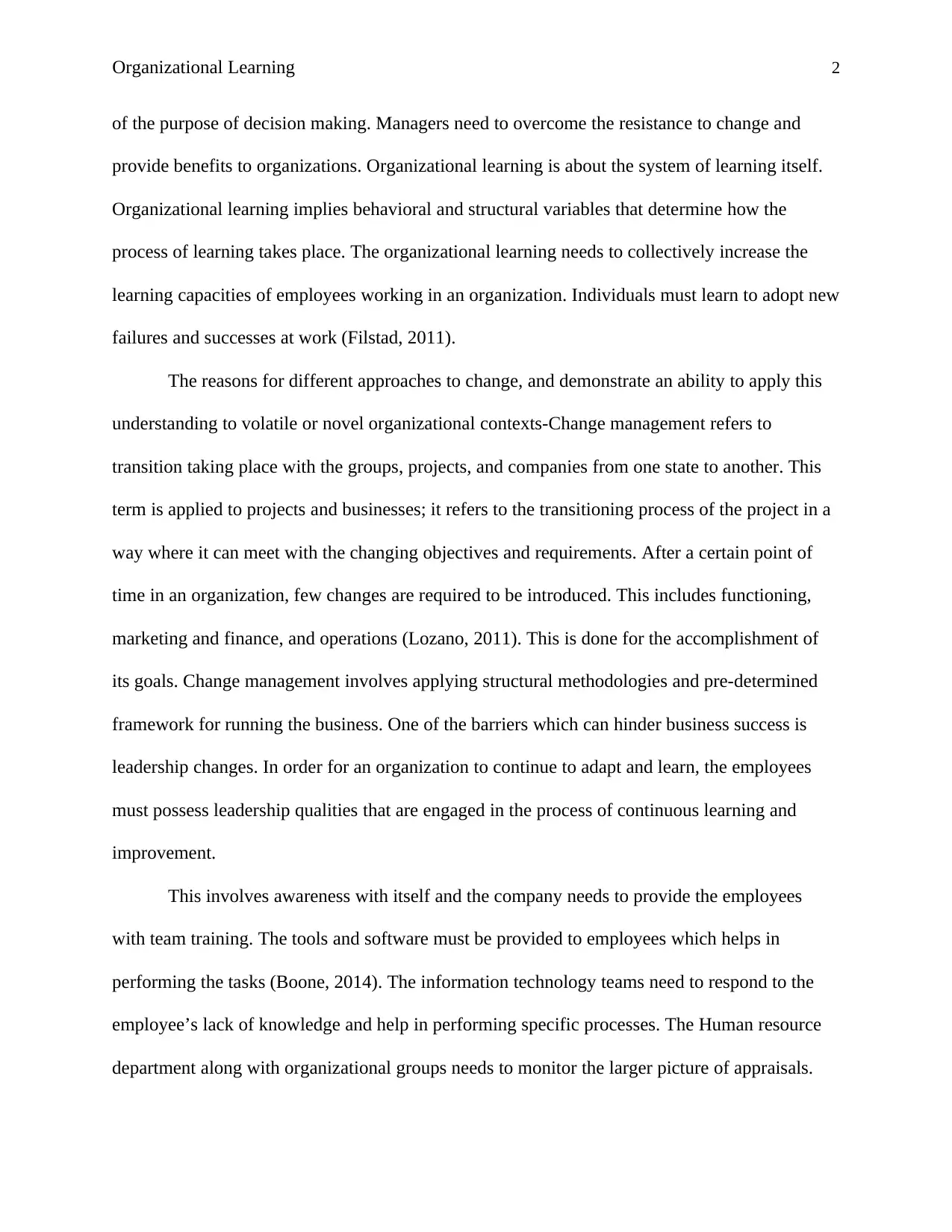
Organizational Learning 2
of the purpose of decision making. Managers need to overcome the resistance to change and
provide benefits to organizations. Organizational learning is about the system of learning itself.
Organizational learning implies behavioral and structural variables that determine how the
process of learning takes place. The organizational learning needs to collectively increase the
learning capacities of employees working in an organization. Individuals must learn to adopt new
failures and successes at work (Filstad, 2011).
The reasons for different approaches to change, and demonstrate an ability to apply this
understanding to volatile or novel organizational contexts-Change management refers to
transition taking place with the groups, projects, and companies from one state to another. This
term is applied to projects and businesses; it refers to the transitioning process of the project in a
way where it can meet with the changing objectives and requirements. After a certain point of
time in an organization, few changes are required to be introduced. This includes functioning,
marketing and finance, and operations (Lozano, 2011). This is done for the accomplishment of
its goals. Change management involves applying structural methodologies and pre-determined
framework for running the business. One of the barriers which can hinder business success is
leadership changes. In order for an organization to continue to adapt and learn, the employees
must possess leadership qualities that are engaged in the process of continuous learning and
improvement.
This involves awareness with itself and the company needs to provide the employees
with team training. The tools and software must be provided to employees which helps in
performing the tasks (Boone, 2014). The information technology teams need to respond to the
employee’s lack of knowledge and help in performing specific processes. The Human resource
department along with organizational groups needs to monitor the larger picture of appraisals.
of the purpose of decision making. Managers need to overcome the resistance to change and
provide benefits to organizations. Organizational learning is about the system of learning itself.
Organizational learning implies behavioral and structural variables that determine how the
process of learning takes place. The organizational learning needs to collectively increase the
learning capacities of employees working in an organization. Individuals must learn to adopt new
failures and successes at work (Filstad, 2011).
The reasons for different approaches to change, and demonstrate an ability to apply this
understanding to volatile or novel organizational contexts-Change management refers to
transition taking place with the groups, projects, and companies from one state to another. This
term is applied to projects and businesses; it refers to the transitioning process of the project in a
way where it can meet with the changing objectives and requirements. After a certain point of
time in an organization, few changes are required to be introduced. This includes functioning,
marketing and finance, and operations (Lozano, 2011). This is done for the accomplishment of
its goals. Change management involves applying structural methodologies and pre-determined
framework for running the business. One of the barriers which can hinder business success is
leadership changes. In order for an organization to continue to adapt and learn, the employees
must possess leadership qualities that are engaged in the process of continuous learning and
improvement.
This involves awareness with itself and the company needs to provide the employees
with team training. The tools and software must be provided to employees which helps in
performing the tasks (Boone, 2014). The information technology teams need to respond to the
employee’s lack of knowledge and help in performing specific processes. The Human resource
department along with organizational groups needs to monitor the larger picture of appraisals.
⊘ This is a preview!⊘
Do you want full access?
Subscribe today to unlock all pages.

Trusted by 1+ million students worldwide
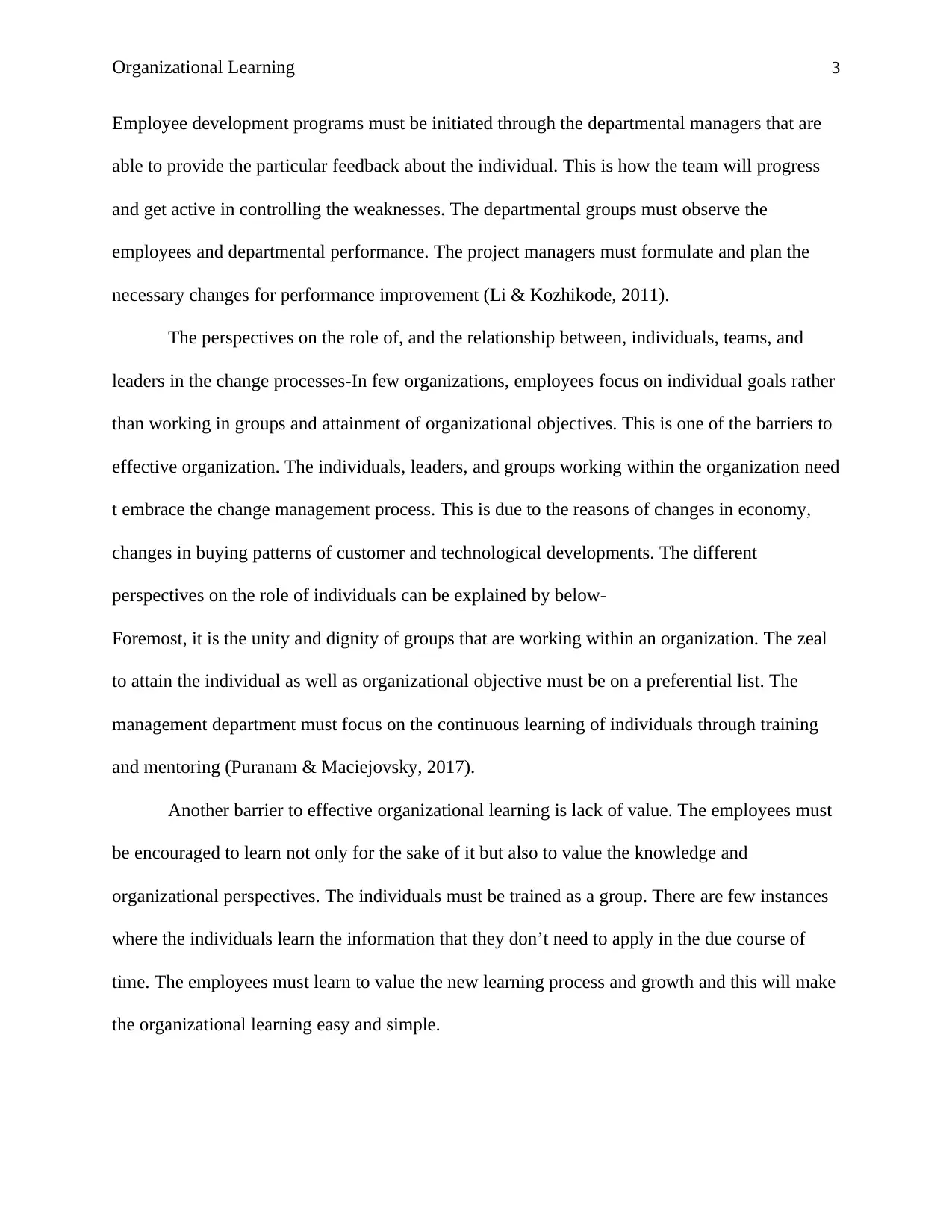
Organizational Learning 3
Employee development programs must be initiated through the departmental managers that are
able to provide the particular feedback about the individual. This is how the team will progress
and get active in controlling the weaknesses. The departmental groups must observe the
employees and departmental performance. The project managers must formulate and plan the
necessary changes for performance improvement (Li & Kozhikode, 2011).
The perspectives on the role of, and the relationship between, individuals, teams, and
leaders in the change processes-In few organizations, employees focus on individual goals rather
than working in groups and attainment of organizational objectives. This is one of the barriers to
effective organization. The individuals, leaders, and groups working within the organization need
t embrace the change management process. This is due to the reasons of changes in economy,
changes in buying patterns of customer and technological developments. The different
perspectives on the role of individuals can be explained by below-
Foremost, it is the unity and dignity of groups that are working within an organization. The zeal
to attain the individual as well as organizational objective must be on a preferential list. The
management department must focus on the continuous learning of individuals through training
and mentoring (Puranam & Maciejovsky, 2017).
Another barrier to effective organizational learning is lack of value. The employees must
be encouraged to learn not only for the sake of it but also to value the knowledge and
organizational perspectives. The individuals must be trained as a group. There are few instances
where the individuals learn the information that they don’t need to apply in the due course of
time. The employees must learn to value the new learning process and growth and this will make
the organizational learning easy and simple.
Employee development programs must be initiated through the departmental managers that are
able to provide the particular feedback about the individual. This is how the team will progress
and get active in controlling the weaknesses. The departmental groups must observe the
employees and departmental performance. The project managers must formulate and plan the
necessary changes for performance improvement (Li & Kozhikode, 2011).
The perspectives on the role of, and the relationship between, individuals, teams, and
leaders in the change processes-In few organizations, employees focus on individual goals rather
than working in groups and attainment of organizational objectives. This is one of the barriers to
effective organization. The individuals, leaders, and groups working within the organization need
t embrace the change management process. This is due to the reasons of changes in economy,
changes in buying patterns of customer and technological developments. The different
perspectives on the role of individuals can be explained by below-
Foremost, it is the unity and dignity of groups that are working within an organization. The zeal
to attain the individual as well as organizational objective must be on a preferential list. The
management department must focus on the continuous learning of individuals through training
and mentoring (Puranam & Maciejovsky, 2017).
Another barrier to effective organizational learning is lack of value. The employees must
be encouraged to learn not only for the sake of it but also to value the knowledge and
organizational perspectives. The individuals must be trained as a group. There are few instances
where the individuals learn the information that they don’t need to apply in the due course of
time. The employees must learn to value the new learning process and growth and this will make
the organizational learning easy and simple.
Paraphrase This Document
Need a fresh take? Get an instant paraphrase of this document with our AI Paraphraser
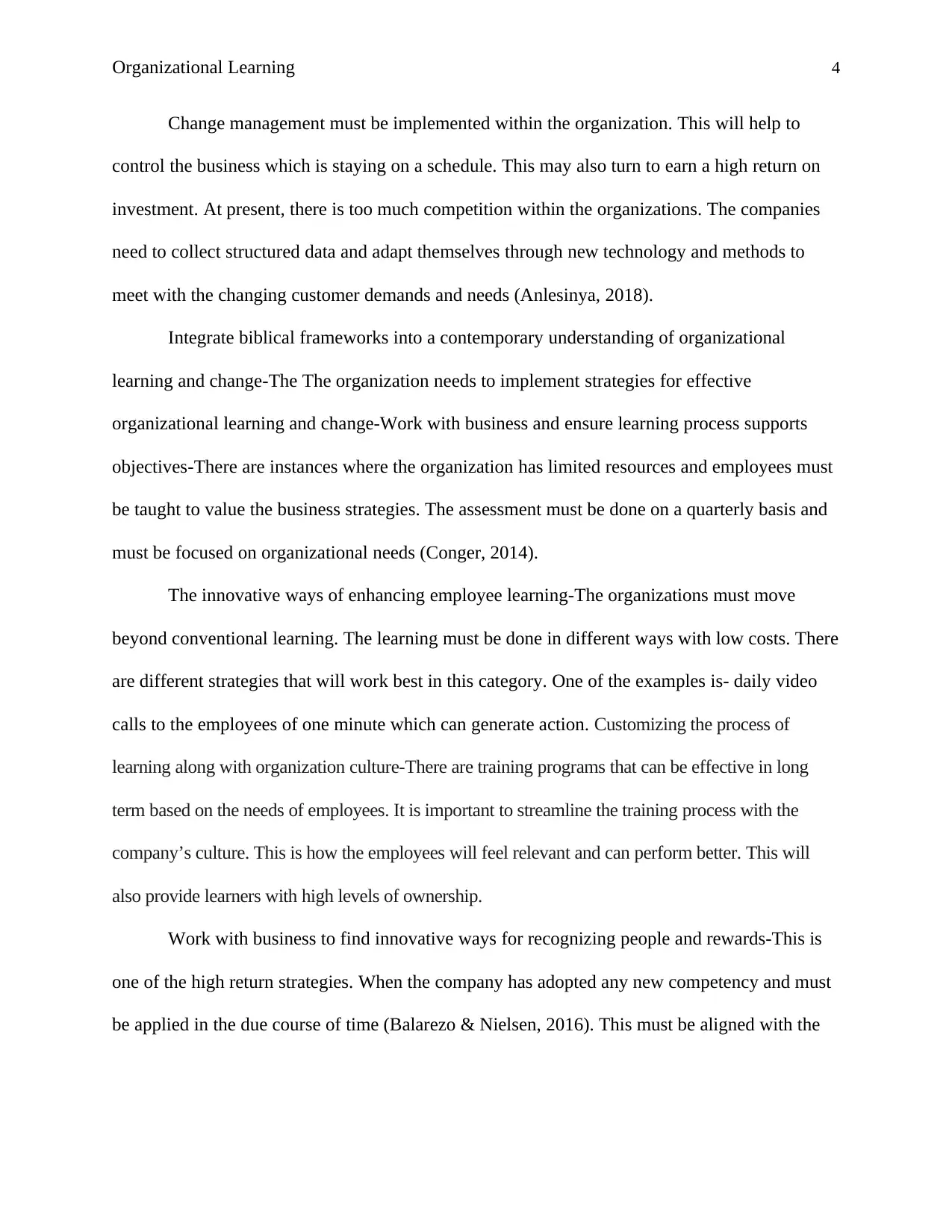
Organizational Learning 4
Change management must be implemented within the organization. This will help to
control the business which is staying on a schedule. This may also turn to earn a high return on
investment. At present, there is too much competition within the organizations. The companies
need to collect structured data and adapt themselves through new technology and methods to
meet with the changing customer demands and needs (Anlesinya, 2018).
Integrate biblical frameworks into a contemporary understanding of organizational
learning and change-The The organization needs to implement strategies for effective
organizational learning and change-Work with business and ensure learning process supports
objectives-There are instances where the organization has limited resources and employees must
be taught to value the business strategies. The assessment must be done on a quarterly basis and
must be focused on organizational needs (Conger, 2014).
The innovative ways of enhancing employee learning-The organizations must move
beyond conventional learning. The learning must be done in different ways with low costs. There
are different strategies that will work best in this category. One of the examples is- daily video
calls to the employees of one minute which can generate action. Customizing the process of
learning along with organization culture-There are training programs that can be effective in long
term based on the needs of employees. It is important to streamline the training process with the
company’s culture. This is how the employees will feel relevant and can perform better. This will
also provide learners with high levels of ownership.
Work with business to find innovative ways for recognizing people and rewards-This is
one of the high return strategies. When the company has adopted any new competency and must
be applied in the due course of time (Balarezo & Nielsen, 2016). This must be aligned with the
Change management must be implemented within the organization. This will help to
control the business which is staying on a schedule. This may also turn to earn a high return on
investment. At present, there is too much competition within the organizations. The companies
need to collect structured data and adapt themselves through new technology and methods to
meet with the changing customer demands and needs (Anlesinya, 2018).
Integrate biblical frameworks into a contemporary understanding of organizational
learning and change-The The organization needs to implement strategies for effective
organizational learning and change-Work with business and ensure learning process supports
objectives-There are instances where the organization has limited resources and employees must
be taught to value the business strategies. The assessment must be done on a quarterly basis and
must be focused on organizational needs (Conger, 2014).
The innovative ways of enhancing employee learning-The organizations must move
beyond conventional learning. The learning must be done in different ways with low costs. There
are different strategies that will work best in this category. One of the examples is- daily video
calls to the employees of one minute which can generate action. Customizing the process of
learning along with organization culture-There are training programs that can be effective in long
term based on the needs of employees. It is important to streamline the training process with the
company’s culture. This is how the employees will feel relevant and can perform better. This will
also provide learners with high levels of ownership.
Work with business to find innovative ways for recognizing people and rewards-This is
one of the high return strategies. When the company has adopted any new competency and must
be applied in the due course of time (Balarezo & Nielsen, 2016). This must be aligned with the

Organizational Learning 5
corporate culture and this will reinforce the learning concept. This is how organizations will
reward the development of innovative capabilities through the process of learning.
Integrate the concepts of organizational learning, strategic and innovative change management
with leadership theory and practice-the organization needs to be planned and take controlled
actions. This can also act as a barrier to effective working of an organization. The company
statistics must be plotted out on charts and graphs or any other organizational procedure through
which the employees can understand the small and long term objectives. This involves long term
planning and control at the small, medium and tp levels of management. The employees must be
taught to look at the big picture by solving short term problems. This must be in the focus to
solve customer queries (Lindberg, 2013).
The organization will be required to implement change strategies and manage change
effectively. It is significant to eradicate irrelevant methods and focus on the appropriate plan of
action. Change management refers to an ongoing process that requires expertise and time and
efforts from the employees and teams. This requires staff involvement along with adaptation of
new technological changes and without being affected by the changes. However, there are
multiple change management tools and approaches that need to be implemented in an
organization and changes will benefit in the long run. Organizational learning is a collective
process through which improvements can be made in individual and group learning processes
(Lehmann, 2017). The dissemination of information must take place at all the hierarchical levels
of organization without any conflict. This will help the employees to make decisions based on
their instincts and information provided. The information collection process must be made clear
and smooth through which employees face fewer problems within the organization (Shaw,
2015).
corporate culture and this will reinforce the learning concept. This is how organizations will
reward the development of innovative capabilities through the process of learning.
Integrate the concepts of organizational learning, strategic and innovative change management
with leadership theory and practice-the organization needs to be planned and take controlled
actions. This can also act as a barrier to effective working of an organization. The company
statistics must be plotted out on charts and graphs or any other organizational procedure through
which the employees can understand the small and long term objectives. This involves long term
planning and control at the small, medium and tp levels of management. The employees must be
taught to look at the big picture by solving short term problems. This must be in the focus to
solve customer queries (Lindberg, 2013).
The organization will be required to implement change strategies and manage change
effectively. It is significant to eradicate irrelevant methods and focus on the appropriate plan of
action. Change management refers to an ongoing process that requires expertise and time and
efforts from the employees and teams. This requires staff involvement along with adaptation of
new technological changes and without being affected by the changes. However, there are
multiple change management tools and approaches that need to be implemented in an
organization and changes will benefit in the long run. Organizational learning is a collective
process through which improvements can be made in individual and group learning processes
(Lehmann, 2017). The dissemination of information must take place at all the hierarchical levels
of organization without any conflict. This will help the employees to make decisions based on
their instincts and information provided. The information collection process must be made clear
and smooth through which employees face fewer problems within the organization (Shaw,
2015).
⊘ This is a preview!⊘
Do you want full access?
Subscribe today to unlock all pages.

Trusted by 1+ million students worldwide
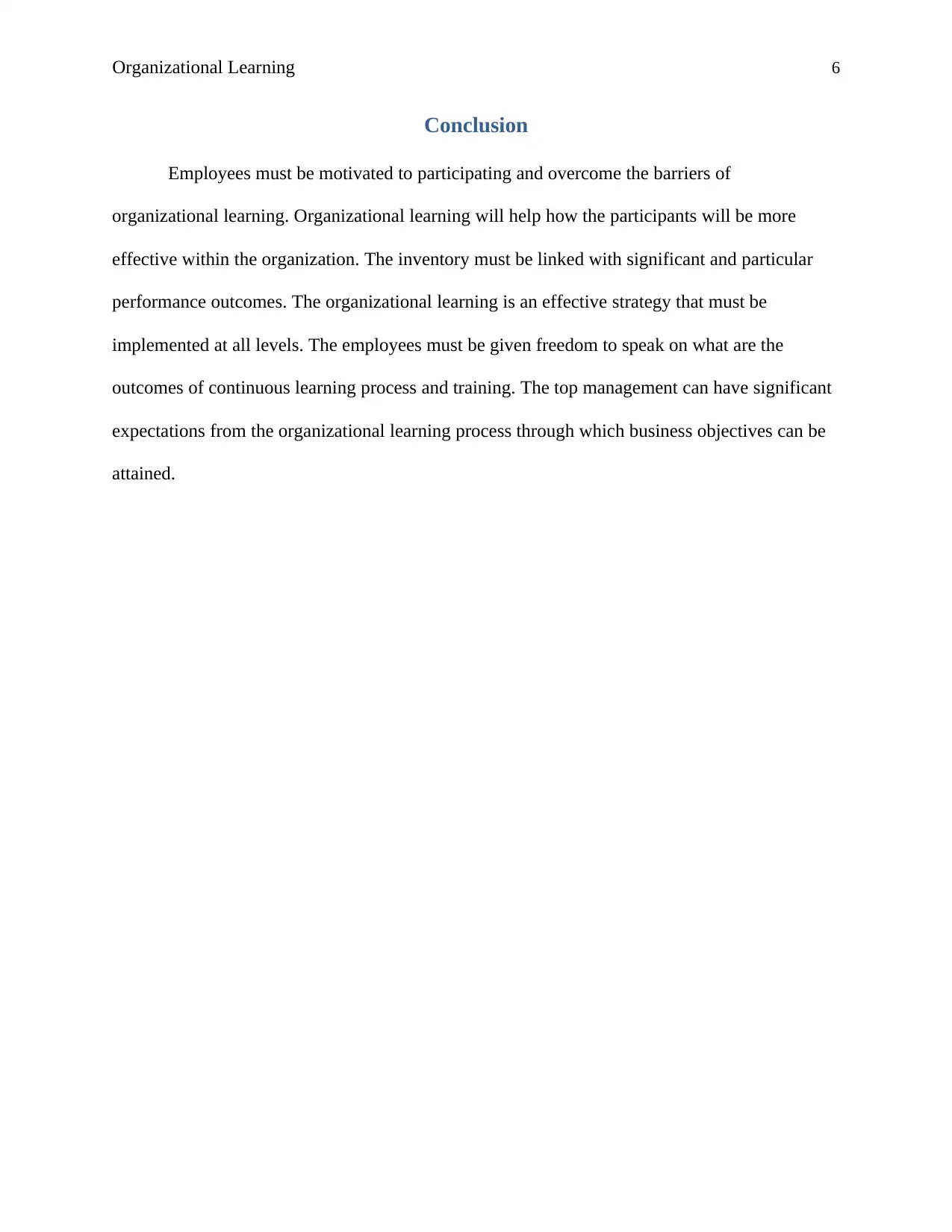
Organizational Learning 6
Conclusion
Employees must be motivated to participating and overcome the barriers of
organizational learning. Organizational learning will help how the participants will be more
effective within the organization. The inventory must be linked with significant and particular
performance outcomes. The organizational learning is an effective strategy that must be
implemented at all levels. The employees must be given freedom to speak on what are the
outcomes of continuous learning process and training. The top management can have significant
expectations from the organizational learning process through which business objectives can be
attained.
Conclusion
Employees must be motivated to participating and overcome the barriers of
organizational learning. Organizational learning will help how the participants will be more
effective within the organization. The inventory must be linked with significant and particular
performance outcomes. The organizational learning is an effective strategy that must be
implemented at all levels. The employees must be given freedom to speak on what are the
outcomes of continuous learning process and training. The top management can have significant
expectations from the organizational learning process through which business objectives can be
attained.
Paraphrase This Document
Need a fresh take? Get an instant paraphrase of this document with our AI Paraphraser
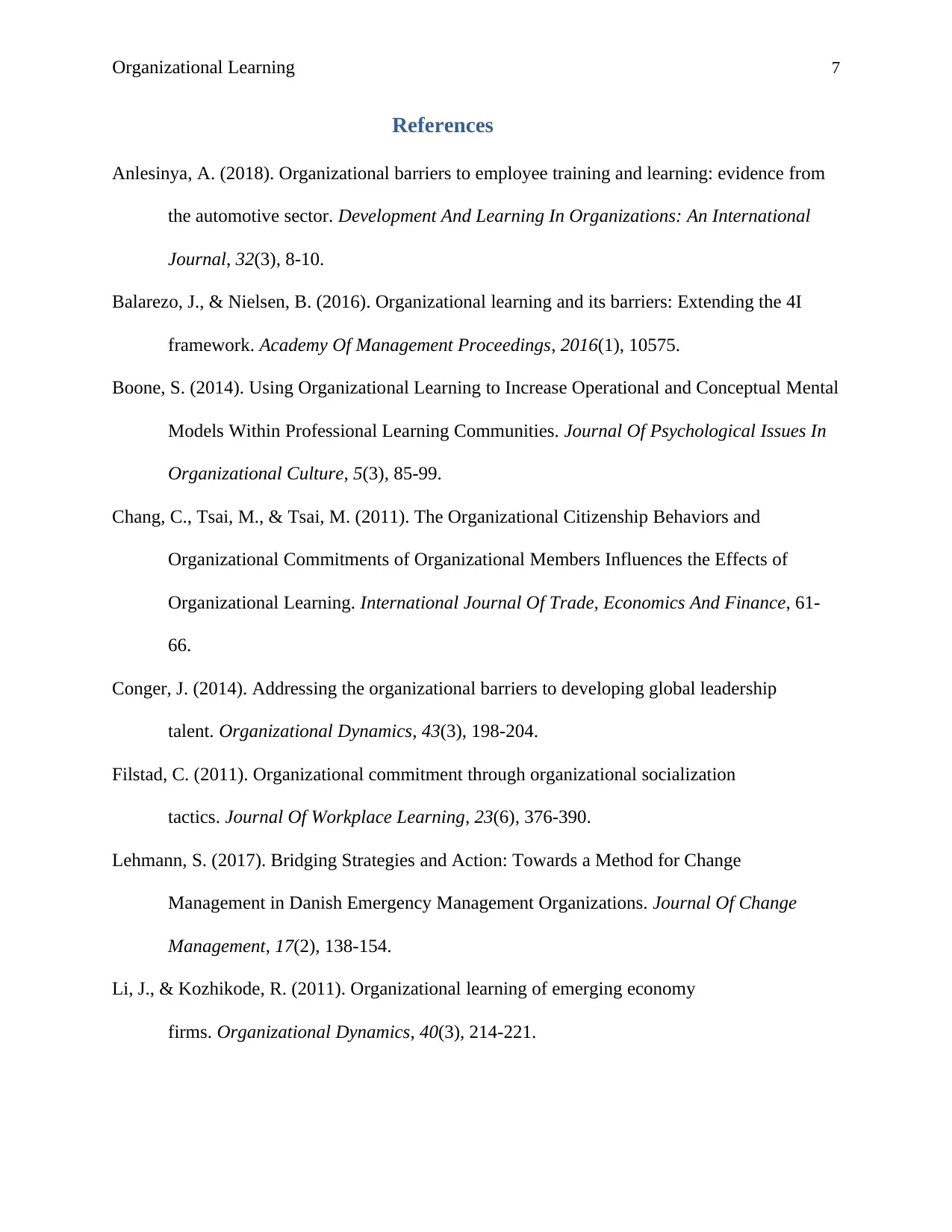
Organizational Learning 7
References
Anlesinya, A. (2018). Organizational barriers to employee training and learning: evidence from
the automotive sector. Development And Learning In Organizations: An International
Journal, 32(3), 8-10.
Balarezo, J., & Nielsen, B. (2016). Organizational learning and its barriers: Extending the 4I
framework. Academy Of Management Proceedings, 2016(1), 10575.
Boone, S. (2014). Using Organizational Learning to Increase Operational and Conceptual Mental
Models Within Professional Learning Communities. Journal Of Psychological Issues In
Organizational Culture, 5(3), 85-99.
Chang, C., Tsai, M., & Tsai, M. (2011). The Organizational Citizenship Behaviors and
Organizational Commitments of Organizational Members Influences the Effects of
Organizational Learning. International Journal Of Trade, Economics And Finance, 61-
66.
Conger, J. (2014). Addressing the organizational barriers to developing global leadership
talent. Organizational Dynamics, 43(3), 198-204.
Filstad, C. (2011). Organizational commitment through organizational socialization
tactics. Journal Of Workplace Learning, 23(6), 376-390.
Lehmann, S. (2017). Bridging Strategies and Action: Towards a Method for Change
Management in Danish Emergency Management Organizations. Journal Of Change
Management, 17(2), 138-154.
Li, J., & Kozhikode, R. (2011). Organizational learning of emerging economy
firms. Organizational Dynamics, 40(3), 214-221.
References
Anlesinya, A. (2018). Organizational barriers to employee training and learning: evidence from
the automotive sector. Development And Learning In Organizations: An International
Journal, 32(3), 8-10.
Balarezo, J., & Nielsen, B. (2016). Organizational learning and its barriers: Extending the 4I
framework. Academy Of Management Proceedings, 2016(1), 10575.
Boone, S. (2014). Using Organizational Learning to Increase Operational and Conceptual Mental
Models Within Professional Learning Communities. Journal Of Psychological Issues In
Organizational Culture, 5(3), 85-99.
Chang, C., Tsai, M., & Tsai, M. (2011). The Organizational Citizenship Behaviors and
Organizational Commitments of Organizational Members Influences the Effects of
Organizational Learning. International Journal Of Trade, Economics And Finance, 61-
66.
Conger, J. (2014). Addressing the organizational barriers to developing global leadership
talent. Organizational Dynamics, 43(3), 198-204.
Filstad, C. (2011). Organizational commitment through organizational socialization
tactics. Journal Of Workplace Learning, 23(6), 376-390.
Lehmann, S. (2017). Bridging Strategies and Action: Towards a Method for Change
Management in Danish Emergency Management Organizations. Journal Of Change
Management, 17(2), 138-154.
Li, J., & Kozhikode, R. (2011). Organizational learning of emerging economy
firms. Organizational Dynamics, 40(3), 214-221.
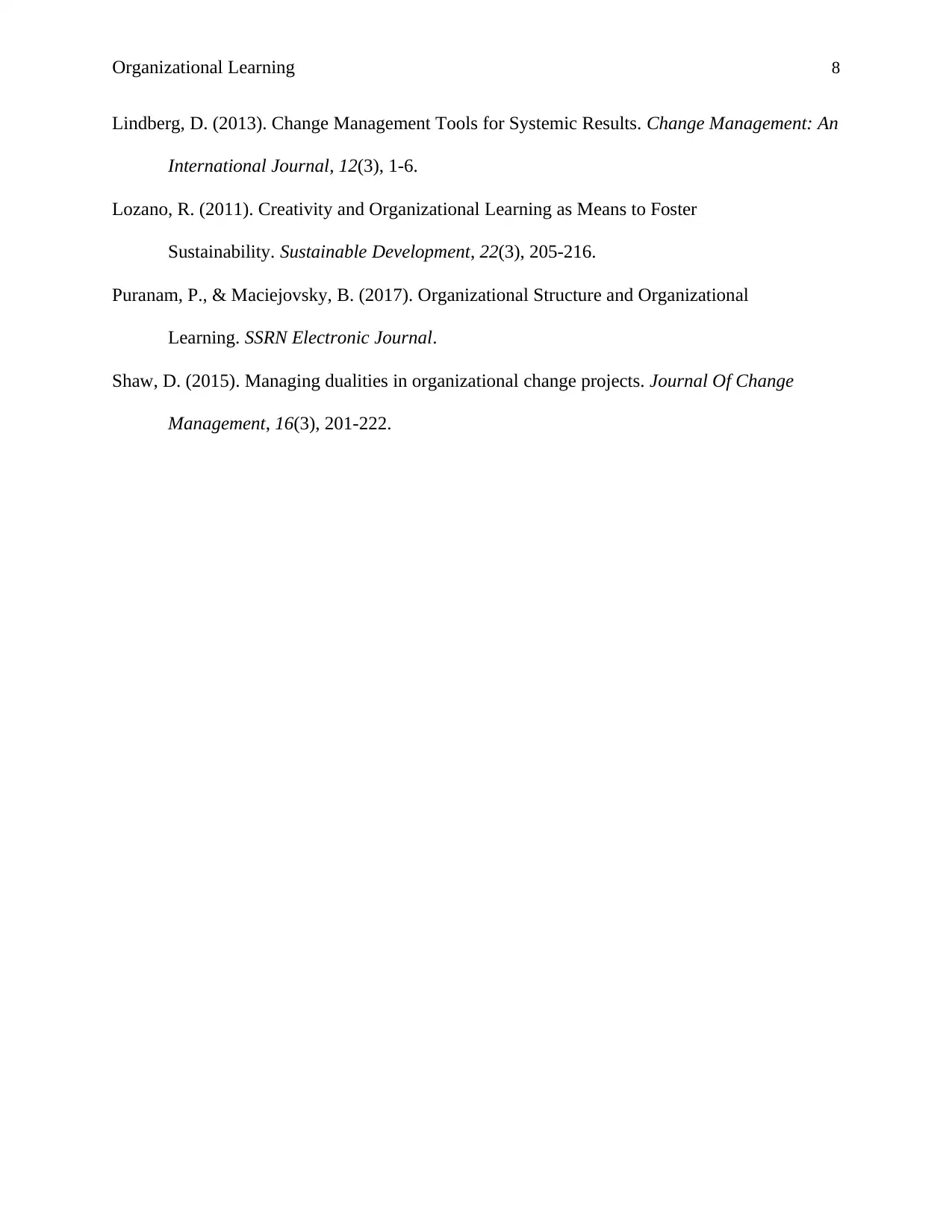
Organizational Learning 8
Lindberg, D. (2013). Change Management Tools for Systemic Results. Change Management: An
International Journal, 12(3), 1-6.
Lozano, R. (2011). Creativity and Organizational Learning as Means to Foster
Sustainability. Sustainable Development, 22(3), 205-216.
Puranam, P., & Maciejovsky, B. (2017). Organizational Structure and Organizational
Learning. SSRN Electronic Journal.
Shaw, D. (2015). Managing dualities in organizational change projects. Journal Of Change
Management, 16(3), 201-222.
Lindberg, D. (2013). Change Management Tools for Systemic Results. Change Management: An
International Journal, 12(3), 1-6.
Lozano, R. (2011). Creativity and Organizational Learning as Means to Foster
Sustainability. Sustainable Development, 22(3), 205-216.
Puranam, P., & Maciejovsky, B. (2017). Organizational Structure and Organizational
Learning. SSRN Electronic Journal.
Shaw, D. (2015). Managing dualities in organizational change projects. Journal Of Change
Management, 16(3), 201-222.
⊘ This is a preview!⊘
Do you want full access?
Subscribe today to unlock all pages.

Trusted by 1+ million students worldwide
1 out of 9
Related Documents
Your All-in-One AI-Powered Toolkit for Academic Success.
+13062052269
info@desklib.com
Available 24*7 on WhatsApp / Email
![[object Object]](/_next/static/media/star-bottom.7253800d.svg)
Unlock your academic potential
Copyright © 2020–2025 A2Z Services. All Rights Reserved. Developed and managed by ZUCOL.





